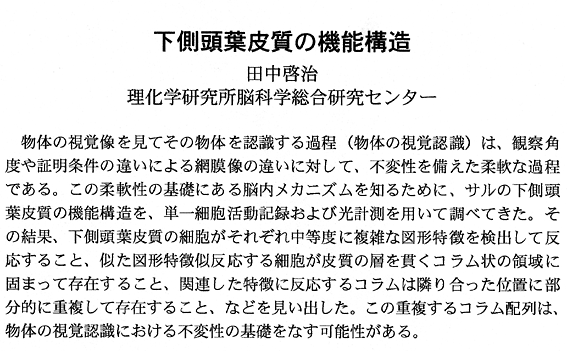Functional architecture in the inferotemporal cortex
Keiji TanakaRIKEN Institute, Saitama 351-01, Japan
Area TE of the monkey inferotemporal cortex represents the final stage of the ventral visual cortical pathway, which is thought to be essential for recognition of objects from their images. The process is flexible, tolerating marked changes in input images caused by differences in illumination, viewing angle, and pose of the object. We have studied the functional architecture of TE to find mechanisms underlying the flexible properties of visual object recognition in primates.
We developed a systematic reduction method to determine the stimulus selectivity of each individual cell: First, many 3-dimensional animal and plant models were presented to the monkey to find the effective stimuli and, second, the images were simplified step by step to determine the features critical for activation. By applying this method to over 300 TE neurons, we found that most of them required moderately complex features for activation. We also observed that cells recorded throughout a vertical penetration responded to similar critical features. Such commonly responding cells were limited to a short span of around 400 µm in length for horizontal penetrations. We thus concluded that there is columnar clustering of cells with similar selectivity. To further study the columnar organization in TE, we used optical imaging. We first determined the critical features for 15 to 25 single cells in several unit-recording sessions; intrinsic signals were then imaged during visual stimulation with the critical features. The image during stimulation with a critical feature, divided by that during stimulation with a control stimulus, revealed activation of a small spot covering the electrode penetration from which the critical feature was determined. The averaged diameter of the activation spot was 490 µm. In addition, different but related critical features determined for different cells recorded in the same penetration evoked response in overlapping regions. Although the activation spots overlapped, the coverage was partial and expanded in different directions from the overlapped area. With a series of experiments with the same doll face, the activation spot moved gradually in one direction as the face turned from the right to the left profile, through the front and 45 deg faces. The size of these overall regions was around 1 mm. Therefore, we have suggested the presence of a continuous map in the space of complex features. Computations may be carried out on this map to realize the flexible properties of object vision in primates.

